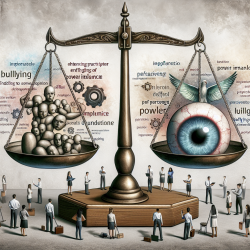Understanding and addressing bullying in schools is a crucial aspect of creating a safe and supportive learning environment. The research article "Measuring 8 to 12-year-old children’s self-report of power imbalance in relation to bullying: development of the Scale of Perceived Power Imbalance" offers valuable insights for practitioners. This blog will explore how practitioners can implement the outcomes of this research to enhance their skills and encourage further research in the field.
Key Findings of the Research
The study focused on developing a reliable self-report instrument, the Scale of Perceived Power Imbalance (SPPI), to measure power imbalance as perceived by children who experience bullying. The SPPI consists of two factors:
- Physical Power: Includes attributes such as physical strength, age, size, and toughness.
- Social Power: Encompasses characteristics valued by peers, such as popularity, cleverness, and appearance.
Implications for Practitioners
Practitioners working in schools can leverage the findings from this research to improve their approach to addressing bullying. Here are some practical steps:
1. Incorporate SPPI in Assessments
Integrate the SPPI into regular assessments to identify children experiencing power imbalances in bullying situations. This tool can help distinguish between different types of power dynamics and provide a clearer understanding of the bullying context.
2. Tailor Interventions
Based on the SPPI results, design targeted interventions that address both physical and social aspects of power imbalance. For example:
- Physical Power: Implement programs that focus on physical safety and empowerment, such as self-defense classes or physical activity programs that build confidence.
- Social Power: Develop social skills training and peer support groups to enhance social inclusion and reduce the impact of social power imbalances.
3. Educate Staff and Students
Conduct training sessions for teachers, school staff, and students to raise awareness about the different forms of power imbalance in bullying. Educating the school community can foster a more supportive environment and encourage bystander intervention.
4. Monitor and Evaluate
Regularly monitor the effectiveness of interventions using the SPPI to track changes in power dynamics and bullying incidents. Continuous evaluation will help refine strategies and ensure they are meeting the needs of the students.
Encouraging Further Research
The SPPI provides a robust framework for understanding power imbalances in bullying, but further research is essential to refine and expand its application. Practitioners are encouraged to:
- Collaborate with researchers to validate the SPPI in different cultural and educational contexts.
- Explore the impact of interventions designed based on SPPI findings on long-term student outcomes.
- Investigate the role of cyberbullying and how power imbalances manifest in digital environments.
To read the original research paper, please follow this link:
Measuring 8 to 12-year-old children’s self-report of power imbalance in relation to bullying: development of the Scale of Perceived Power Imbalance.










